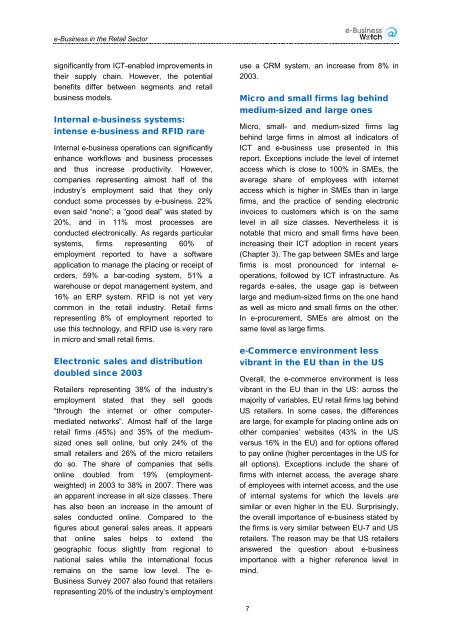ICT and e-Business Impact in the Retail Industry - empirica
ICT and e-Business Impact in the Retail Industry - empirica
ICT and e-Business Impact in the Retail Industry - empirica
- No tags were found...
Create successful ePaper yourself
Turn your PDF publications into a flip-book with our unique Google optimized e-Paper software.
e-<strong>Bus<strong>in</strong>ess</strong> <strong>in</strong> <strong>the</strong> <strong>Retail</strong> Sectorsignificantly from <strong>ICT</strong>-enabled improvements <strong>in</strong><strong>the</strong>ir supply cha<strong>in</strong>. However, <strong>the</strong> potentialbenefits differ between segments <strong>and</strong> retailbus<strong>in</strong>ess models.Internal e-bus<strong>in</strong>ess systems:<strong>in</strong>tense e-bus<strong>in</strong>ess <strong>and</strong> RFID rareInternal e-bus<strong>in</strong>ess operations can significantlyenhance workflows <strong>and</strong> bus<strong>in</strong>ess processes<strong>and</strong> thus <strong>in</strong>crease productivity. However,companies represent<strong>in</strong>g almost half of <strong>the</strong><strong>in</strong>dustry’s employment said that <strong>the</strong>y onlyconduct some processes by e-bus<strong>in</strong>ess. 22%even said “none”; a “good deal” was stated by20%, <strong>and</strong> <strong>in</strong> 11% most processes areconducted electronically. As regards particularsystems, firms represent<strong>in</strong>g 60% ofemployment reported to have a softwareapplication to manage <strong>the</strong> plac<strong>in</strong>g or receipt oforders, 59% a bar-cod<strong>in</strong>g system, 51% awarehouse or depot management system, <strong>and</strong>16% an ERP system. RFID is not yet verycommon <strong>in</strong> <strong>the</strong> retail <strong>in</strong>dustry. <strong>Retail</strong> firmsrepresent<strong>in</strong>g 8% of employment reported touse this technology, <strong>and</strong> RFID use is very rare<strong>in</strong> micro <strong>and</strong> small retail firms.Electronic sales <strong>and</strong> distributiondoubled s<strong>in</strong>ce 2003<strong>Retail</strong>ers represent<strong>in</strong>g 38% of <strong>the</strong> <strong>in</strong>dustry’semployment stated that <strong>the</strong>y sell goods“through <strong>the</strong> <strong>in</strong>ternet or o<strong>the</strong>r computermediatednetworks”. Almost half of <strong>the</strong> largeretail firms (45%) <strong>and</strong> 35% of <strong>the</strong> mediumsizedones sell onl<strong>in</strong>e, but only 24% of <strong>the</strong>small retailers <strong>and</strong> 26% of <strong>the</strong> micro retailersdo so. The share of companies that sellsonl<strong>in</strong>e doubled from 19% (employmentweighted)<strong>in</strong> 2003 to 38% <strong>in</strong> 2007. There wasan apparent <strong>in</strong>crease <strong>in</strong> all size classes. Therehas also been an <strong>in</strong>crease <strong>in</strong> <strong>the</strong> amount ofsales conducted onl<strong>in</strong>e. Compared to <strong>the</strong>figures about general sales areas, it appearsthat onl<strong>in</strong>e sales helps to extend <strong>the</strong>geographic focus slightly from regional tonational sales while <strong>the</strong> <strong>in</strong>ternational focusrema<strong>in</strong>s on <strong>the</strong> same low level. The e-<strong>Bus<strong>in</strong>ess</strong> Survey 2007 also found that retailersrepresent<strong>in</strong>g 20% of <strong>the</strong> <strong>in</strong>dustry’s employmentuse a CRM system, an <strong>in</strong>crease from 8% <strong>in</strong>2003.Micro <strong>and</strong> small firms lag beh<strong>in</strong>dmedium-sized <strong>and</strong> large onesMicro, small- <strong>and</strong> medium-sized firms lagbeh<strong>in</strong>d large firms <strong>in</strong> almost all <strong>in</strong>dicators of<strong>ICT</strong> <strong>and</strong> e-bus<strong>in</strong>ess use presented <strong>in</strong> thisreport. Exceptions <strong>in</strong>clude <strong>the</strong> level of <strong>in</strong>ternetaccess which is close to 100% <strong>in</strong> SMEs, <strong>the</strong>average share of employees with <strong>in</strong>ternetaccess which is higher <strong>in</strong> SMEs than <strong>in</strong> largefirms, <strong>and</strong> <strong>the</strong> practice of send<strong>in</strong>g electronic<strong>in</strong>voices to customers which is on <strong>the</strong> samelevel <strong>in</strong> all size classes. Never<strong>the</strong>less it isnotable that micro <strong>and</strong> small firms have been<strong>in</strong>creas<strong>in</strong>g <strong>the</strong>ir <strong>ICT</strong> adoption <strong>in</strong> recent years(Chapter 3). The gap between SMEs <strong>and</strong> largefirms is most pronounced for <strong>in</strong>ternal e-operations, followed by <strong>ICT</strong> <strong>in</strong>frastructure. Asregards e-sales, <strong>the</strong> usage gap is betweenlarge <strong>and</strong> medium-sized firms on <strong>the</strong> one h<strong>and</strong>as well as micro <strong>and</strong> small firms on <strong>the</strong> o<strong>the</strong>r.In e-procurement, SMEs are almost on <strong>the</strong>same level as large firms.e-Commerce environment lessvibrant <strong>in</strong> <strong>the</strong> EU than <strong>in</strong> <strong>the</strong> USOverall, <strong>the</strong> e-commerce environment is lessvibrant <strong>in</strong> <strong>the</strong> EU than <strong>in</strong> <strong>the</strong> US: across <strong>the</strong>majority of variables, EU retail firms lag beh<strong>in</strong>dUS retailers. In some cases, <strong>the</strong> differencesare large, for example for plac<strong>in</strong>g onl<strong>in</strong>e ads ono<strong>the</strong>r companies’ websites (43% <strong>in</strong> <strong>the</strong> USversus 16% <strong>in</strong> <strong>the</strong> EU) <strong>and</strong> for options offeredto pay onl<strong>in</strong>e (higher percentages <strong>in</strong> <strong>the</strong> US forall options). Exceptions <strong>in</strong>clude <strong>the</strong> share offirms with <strong>in</strong>ternet access, <strong>the</strong> average shareof employees with <strong>in</strong>ternet access, <strong>and</strong> <strong>the</strong> useof <strong>in</strong>ternal systems for which <strong>the</strong> levels aresimilar or even higher <strong>in</strong> <strong>the</strong> EU. Surpris<strong>in</strong>gly,<strong>the</strong> overall importance of e-bus<strong>in</strong>ess stated by<strong>the</strong> firms is very similar between EU-7 <strong>and</strong> USretailers. The reason may be that US retailersanswered <strong>the</strong> question about e-bus<strong>in</strong>essimportance with a higher reference level <strong>in</strong>m<strong>in</strong>d.7
















